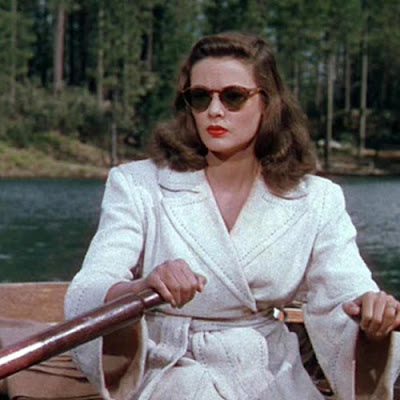Watched: 04/01/2023
Format: Criterion Disc
Viewing: First
Director: John M. Stahl
It's funny how certain films experience a bit of trendiness within the classic film community or film noir world. But, here's the thing, rarely is the surge of enthusiasm unearned.
Leave Her to Heaven (1945) was buzzy a year or so ago. I tried to watch it on the Criterion Channel but occasionally Criterion blips when I try to watch it, and I was literally watching it the day before it left and gave up. So I took a gamble and with the recent Criterion sale picked up the BluRay. And I am not disappointed. Appropriate buzzing, classic film nerds.
I have zero problem with a good, dark melodrama that bleeds into early noir, and, boy howdy, is this that. Heck, I just like a good melodrama these days.*
The movie is about a woman (Gene Tierney) who, while going to spread her father's ashes with her mother and adopted sister (Jeanne Crain), meets an author (Cornel Wilde). All are from Boston and find they enjoy one another's company and Wilde and Tierney fall for each other even though she's engaged to a politician (Vincent Price!) - which she breaks off long distance.
The author and Tierney rush into marriage at her insistence, moving first to be near Wilde's brother who is ill and disabled, but when he's about to be discharged and well enough to live with Tierney and Wilde, the first (massive) cracks really begin to show. Not that there weren't signs.
Anyway - let's just say Tierney really, really just wants things to be just her and Wilde. You know how in middle school they start telling you "if people tell you not to spend time with people you love, that's emotional abuse"? This is that: the movie.
Wilde is fairly solid as the husband realizing he's married a psychopath, and Craine is lovely as the non-crazy sibling. A pre-horror Price is more story point than developed character, but it's a reminder of his range and maybe gives shadows of his more intense later performances.
I've only seen a very small selection of Gene Tierney's work, and she did receive an Oscar nom for this, losing to Joan Crawford for Mildred Pierce (sounds like the wartime pictures were creating an interesting opportunity for female driven films in 1945). She's @#$%ing phenomenal here. Absolutely nuts and absolutely still appealing to watch, with maybe one of the most chilling murders I've seen in a movie, paired with maybe one of the most insane moments I've seen out of a character on film. It's some incredibly dark stuff.
Without saying it, there's some straight up wild Oedipal/ Electra-complex stuff in the film that's pretty mind-boggling and squicky, doing something that would maybe freak out filmmakers from a major studio now. Weird that any of this flew during the Hayes-era, but they made it work.
I would think you can't talk about this movie without pondering the very weird Technicolor of the thing - but I can't find anything written about the peculiar use of Technicolor in the movie - which generously colors the outdoor landscapes of pine-surrounded lakes, the Arizona desert, etc... and which pushes the ruby lipstick of Tierney. Interiors can seem almost surreal, such as the odd spring-green court room or the lavishly planted desert resort. Anglo flesh is almost the same color as colorized films of the 1990's unless rouge and eye shadow are applied. The overall look is much the same as print ads of the era, with punchy primaries and other hues not quite looking like real flesh tones. Which is a bit odd 7 years after Gone with the Wind made color film seem like a workable idea or the candy-colored world of Wizard of Oz in 1939. All That Heaven Allows and its astounding color palette is still ten years away.
The scene that will burn itself into your brain from the movie is Tierney's rowboat sequence on the lake with her young brother-in-law. Here's one for the film students, noir fans and folks wanting to see how color can be used in a movie. Absolutely stunning stuff.
Anyway, would love to revisit this one soon, and I now have it on disc, so easy enough.
*a glance at the Wikipedia article for the film will leave you pondering why on earth we spend so much time worrying, post-facto, about categorizing films, especially when they criss-cross a half-dozen boxes we'd like to shove them into. I get the utility of categorization in some ways, but basically feel anything - like this film - that could be lumped in to any of a half-dozen categories should be celebrated rather than create arguments about why the movie is in the box of your choosing.

.jpg)

No comments:
Post a Comment